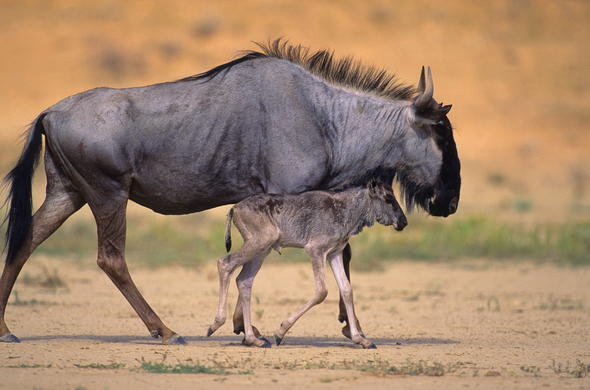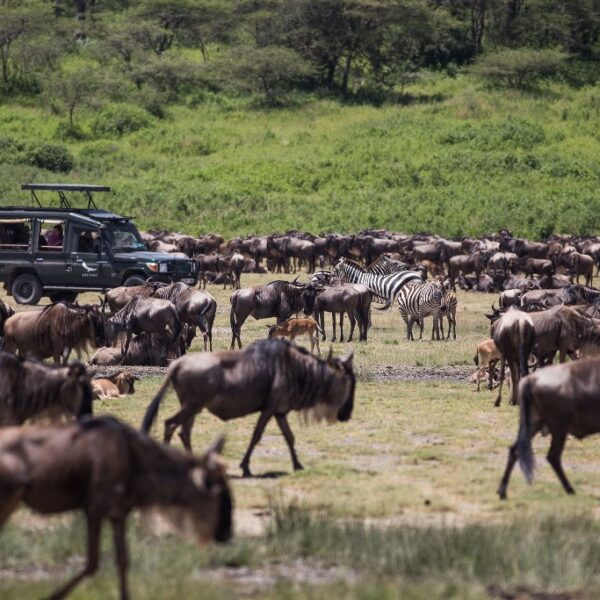When it comes to iconic wildlife destinations, Kenya holds a place of honor on the global stage. A land of vast savannahs, acacia-dotted plains, misty highlands, and shimmering lakes, Kenya is synonymous with the classic African safari. Its national parks and reserves are teeming with wildlife, making it one of the few places on earth where you can witness the famed “Big Five” and encounter dozens of other extraordinary species — all within a single itinerary.
In this comprehensive guide, we will introduce you to the Big Five and take you beyond them, revealing the full spectrum of Kenya’s wildlife — from rare predators and elegant antelopes to flocks of dazzling flamingos and over a thousand bird species. Whether you’re a first-time safari-goer or a seasoned traveler, Kenya offers unforgettable moments in the wild.
The Big Five: Kenya’s Most Famous Residents
The term “Big Five” refers to five of Africa’s most powerful and admired animals — lion, elephant, leopard, rhinoceros, and Cape buffalo. Historically named by big-game hunters as the most challenging animals to hunt on foot, these species are now the top wildlife sightings for safari enthusiasts and wildlife photographers.
Lion
No African safari feels complete without the sight of a lion resting beneath an acacia tree or stalking prey through golden grasses. Lions in Kenya are often seen in prides and are known for their social structure and cooperative hunting behavior. The Masai Mara National Reserve is one of the best places in Africa to observe lions in the wild, particularly during the Great Migration when large numbers of wildebeest and zebra cross into Kenya from Tanzania, providing a seasonal feast for these powerful predators.
African Elephant
Kenya is home to large populations of African elephants, the largest land mammals on Earth. Amboseli National Park is perhaps the most iconic destination to observe elephants in their natural habitat. With the snow-capped peaks of Mount Kilimanjaro as a backdrop, visitors to Amboseli often witness elephants in large herds, moving gracefully through the dusty plains or bathing in swampy marshes. Their intelligence, complex social structures, and emotional depth make elephant sightings deeply moving.
Leopard
Leopards are solitary and stealthy cats, known for their elusive nature and exceptional climbing skills. Although they are widespread across Kenya, spotting a leopard often requires patience and a sharp eye. They are most commonly seen in the Masai Mara and Samburu National Reserve, usually draped over tree branches or silently moving through the bush in the early morning or late evening. Their spotted coats provide near-perfect camouflage, making every sighting a thrill.
Rhinoceros
Both black and white rhinos are found in Kenya, although they are critically endangered due to decades of poaching. The country has taken significant conservation measures to protect its rhino populations. Lake Nakuru National Park offers a good chance of seeing both black and white rhinos, while private conservancies like Ol Pejeta and Lewa Wildlife Conservancy have become strongholds for rhino conservation. These sanctuaries offer visitors a rare opportunity to observe rhinos in safety and at close range.
Cape Buffalo
Sturdy, unpredictable, and surprisingly dangerous, the Cape buffalo is one of Africa’s most formidable animals. They are often seen in massive herds, especially near rivers and wetlands. Despite their docile appearance, buffaloes are known to be aggressive when threatened. They are common in most major Kenyan parks, including Tsavo, Aberdare, and the Mara.
Beyond the Big Five: Kenya’s Diverse and Remarkable Wildlife
While the Big Five are iconic, they represent only a fraction of the extraordinary wildlife that thrives in Kenya. The country’s rich and varied landscapes — from the savannahs and mountains to forests and lakes — support an astonishing variety of mammals, birds, reptiles, and insects.
Cheetah
Sleek, agile, and built for speed, the cheetah is the world’s fastest land animal and a breathtaking sight on the Kenyan plains. Unlike other big cats, cheetahs prefer open landscapes where they can use their speed to hunt. The Masai Mara is an excellent place to observe cheetahs in action, especially when mothers are teaching their young to hunt. Unlike leopards, cheetahs are diurnal and are often active during the day, providing great photographic opportunities.
Giraffe
Kenya is home to three subspecies of giraffes — the Maasai giraffe, the Reticulated giraffe, and the Rothschild’s giraffe. The Maasai giraffe, with its irregular, jagged spots, is the most common and can be found across the country. The Reticulated giraffe, with its distinctive geometric patterns, is native to northern Kenya, particularly in Samburu. Rothschild’s giraffes are primarily found in conservation areas like Giraffe Centre in Nairobi and Lake Nakuru National Park. Observing these gentle giants feeding on treetops is one of the most peaceful and elegant safari experiences.
Zebra
Zebras are a staple of the Kenyan landscape and can often be seen grazing alongside wildebeests and antelope. The more common plains zebra is found across most of Kenya’s parks, while the rarer and more endangered Grevy’s zebra — with its narrow stripes and large ears — is found in northern Kenya. Zebras are highly social animals and their tight-knit herds are a joy to observe.
African Wild Dog
Also known as painted wolves, African wild dogs are among the most endangered carnivores in Africa. Once widespread, their numbers have dwindled due to habitat loss and conflict with humans. However, they can still be found in remote parts of Laikipia, Tsavo, and Samburu. Known for their strong pack bonds and strategic hunting methods, wild dog sightings are incredibly rare and highly rewarding.
Hippopotamus and Nile Crocodile
Rivers and lakes across Kenya provide habitats for both hippos and crocodiles. Hippos are commonly seen in Lake Naivasha and along the Mara River, where they spend their days submerged in water to stay cool. Crocodiles, especially those in the Mara River, are famous for their dramatic interactions during the Great Migration, when thousands of wildebeests risk crossing predator-infested waters.
Flamingo
Kenya’s alkaline Rift Valley lakes, particularly Lake Nakuru, Lake Bogoria, and Lake Elementaita, are known for their spectacular flocks of flamingos. Depending on water levels and food availability, the pink tide of flamingos can be truly awe-inspiring. These birds feed on algae and crustaceans in the shallow waters, creating one of Africa’s most visually stunning spectacles.
Kenya’s Avian Wonderland: A Birdwatcher’s Paradise
Kenya is a haven for bird lovers, with over 1,100 recorded bird species — ranging from tiny sunbirds to majestic raptors. Some notable birds include:
- The vibrant lilac-breasted roller, Kenya’s national bird
- The striking secretary bird, often seen stalking prey on foot
- The African fish eagle, with its piercing call and regal presence near lakes
- Colorful bee-eaters, weavers, and kingfishers
- Migratory species from Europe and Asia that arrive during northern winters
Birding is especially rewarding in Lake Baringo, Kakamega Forest, and around Mount Kenya and the Aberdares.
Reptiles, Amphibians, and Insects: The Smaller Wonders
Kenya also boasts a fascinating collection of smaller creatures. Monitor lizards, chameleons, geckos, and a variety of snakes inhabit its forests and savannahs. Butterflies, dragonflies, and dazzling beetles add vibrant colors to the landscape, especially during the rainy seasons. Though often overlooked, these animals play vital roles in Kenya’s ecosystems.
A Commitment to Conservation
Kenya is not only a sanctuary for some of the world’s most remarkable wildlife, but also a global pioneer in conservation. The country has taken bold steps to protect its natural heritage, implementing policies, education programs, and community initiatives that prioritize ecological sustainability alongside economic development. These efforts have made Kenya a beacon of hope in the fight against poaching, habitat destruction, and species extinction.
Government and Institutional Initiatives
The Kenya Wildlife Service (KWS), a state corporation under the Ministry of Tourism and Wildlife, plays a central role in managing national parks and reserves. KWS is instrumental in anti-poaching efforts, wildlife census operations, and the management of human-wildlife conflict, ensuring that Kenya’s rich biodiversity is preserved for future generations. Through strong law enforcement and public engagement, KWS has helped stabilize or increase populations of vulnerable species such as elephants, rhinos, and lions.
Private and Non-Governmental Contributions
Alongside government initiatives, organizations such as the David Sheldrick Wildlife Trust (DSWT) have had a profound impact on wildlife conservation. DSWT is internationally recognized for its orphaned elephant rescue and rehabilitation program, offering a second chance to calves that have lost their mothers to poaching or drought. The trust also engages in mobile veterinary units, aerial surveillance, and public education campaigns that foster a deeper understanding of the challenges wildlife face.
Other key players include the Lewa Wildlife Conservancy, Ol Pejeta Conservancy, and Northern Rangelands Trust, which focus on innovative conservation models that blend ecotourism with local empowerment. These conservancies have become safe havens for critically endangered species, such as the black rhino and Grevy’s zebra, while creating jobs, schools, and healthcare services for the communities that surround them.
Community-Led Conservation
Perhaps one of the most inspiring aspects of Kenya’s conservation story is the growing involvement of local communities. Indigenous groups like the Maasai and Samburu have become central partners in wildlife protection, often managing community conservancies and guiding eco-tourism experiences. By aligning conservation goals with tangible economic benefits — such as employment, education, and infrastructure — Kenya has demonstrated that wildlife can thrive when people are seen not as threats, but as stewards of the land.
Programs that offer revenue-sharing from park entry fees or support women’s cooperatives through wildlife tourism have empowered entire communities. This collaborative approach reduces the need for activities like poaching or illegal grazing, creating a cycle of mutual benefit between nature and people.
How Travelers Make a Difference
Every visit to Kenya contributes directly to these conservation efforts. Park entry fees, lodge levies, and guided safari experiences support both protected area management and local development projects. By choosing responsible tour operators and staying in eco-conscious lodges, travelers become active participants in preserving Kenya’s wildlife and landscapes.
Moreover, many safari itineraries now offer opportunities for visitors to learn about conservation firsthand — whether by visiting an elephant orphanage, taking part in tree planting, or simply hearing the stories of the rangers and communities who protect the wild.
Conclusion: More Than a Safari — A Wildlife Journey
Kenya is more than a destination — it’s a living, breathing testament to the untamed beauty of nature. Here, ancient migration routes pulse with life, lions roar beneath starlit skies, and each sunrise brings a new story across the savannah. From the towering peak of Mount Kilimanjaro to the mirror-like lakes of the Rift Valley, Kenya offers more than just breathtaking sights — it offers profound connection.
Yes, the Big Five draw visitors from around the world, but the true magic lies in the moments in between: the stillness before a cheetah sprints, the soft call of a distant bird at dawn, and the warmth of a fire after a day spent tracking wildlife through golden grasses. It’s in the footprints of elephants, the rustle of acacia leaves, and the quiet thrill of standing in a world untouched by time.
A safari in Kenya is not just about ticking off animals — it’s about rediscovering a deeper part of ourselves. It stirs the senses, ignites curiosity, and inspires reverence for the wild.
If you’re seeking more than just a holiday — if you’re searching for an experience that stays with you long after you leave — then Kenya is not just calling. It’s ready to welcome you.



